Development Trends Of Solar Power Inverter System In The Iran Market
 Oct 07,2024
Oct 07,2024
 45
45
 XINDUN
XINDUN
With the global energy transformation and sustainable development, Iran, as an important country in the Middle East, it is also an energy powerhouse, and the solar industry is gradually becoming a key link in Iran solar energy structure transformation. Iran has unique geographical conditions and abundant sunshine resources, which provide a solid foundation for the development of the solar power industry. So what is the current development status of Iran solar power industry?
Therefore, below, Xindun will discuss and analyze the market development prospects of Iran solar power systems, and conduct an in-depth analysis of the current situation, potential, challenges and opportunities of Iran solar, which will help dealers to develop the local solar energy market in Iran.
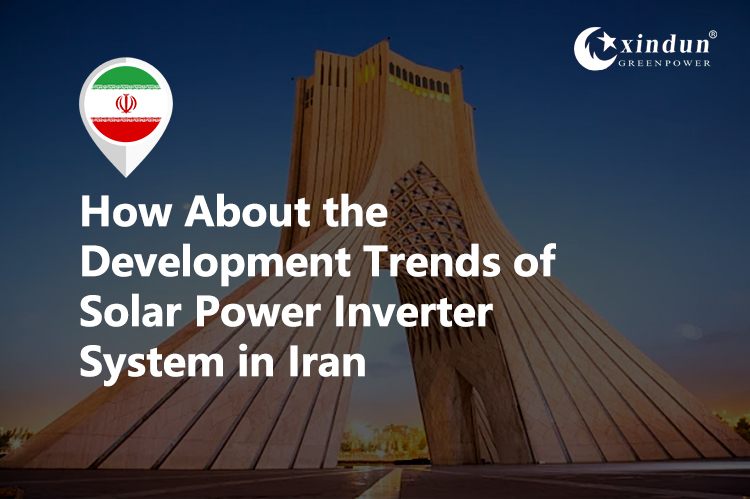
I.Current status of Iran power generation electricity structure
Let's first understand how Iran's energy power electricity structure is composed, and what proportion of it is solar power?
According to the data of SRWE 2024 report, in 2023, Iran's total power generation is 382.9 terawatt hours (TWh), and Iran's power structure includes gas power generation, oil power generation, hydropower and renewable energy power generation (such as solar and wind power). Among them, natural gas is Iran largest energy generation, accounting for 84.5% of total power generation, oil accounts for 7% of Iran total power generation, hydropower accounts for 5.9%, of which renewable energy power generation accounts for 1.8%, nuclear power generation accounts for 1.7%, and coal power generation accounts for 0.2%, achieving a year-on-year growth of 4.3% compared with 2022.
|
|
Other TWh |
Natural Gas TWh |
Natural Gas TWh |
Nuclear Energy TWh |
Hydropower TWh
|
Renewable Energy TWh |
Other TWh
|
Total TWh
|
|
Iran |
26.9 |
323.6 |
0.9 |
6.6 |
22.7 |
7.1 |
- |
382.9 |
|
2023 Electricity generation in Iran |
||||||||
|
|
Other %
|
Natural Gas % |
Raw Coal %
|
Nuclear Energy % |
Hydropower %
|
Renewable Energy % |
Other %
|
Total %
|
|
Iran |
7 |
84.5 |
0.2 |
1.7 |
5.9 |
1.8 |
- |
382.9 |
|
2023 Proportion of Iran's electricity generation structure |
||||||||
|
|
Wind power TWh |
Solar power TWh |
Hydropower TWh |
Other TWh |
Total TWh |
|||
|
Iran |
1.3 |
0.8 |
22.7 |
- |
24.8 |
|||
|
2023 Renewable energy generation in Iran |
||||||||
Although Iran is rich in solar energy resources, in 2023, Iran's solar power generation will be 0.8 terawatt hours (TWh), and solar power will account for about 0.21% of the total power generation. From Iran's geographical conditions, Iran is close to the equator, of which 90% of the land area can provide at least 300 days of solar energy per year, the average daily radiation of about 19.50MJ/m ², such as Kerman, Fars, Isfahan and Azd province, the annual radiation of up to 2511kWh/m ², Iran has sufficient sunshine resources, There are plenty of sunny days each year, with a long average day. Such geographical and climatic conditions provide a good natural basis for solar power and have huge potential for solar power.
Due to the current situation of Iran solar energy structure, technical and economic factors, market demand and policy environment and other reasons, Iran solar power generation has not been fully developed and utilized. At present, the Iran government has begun to attach importance to the development of solar, and plans to increase the proportion of renewable energy in the power structure in the next few years, of which solar power generation is the top priority, to increase the development of solar power generation investment proportion.
II.The challenge of electricity shortage in Iran
According to the latest report of Farda Radio on August 29, the current electricity shortage in Iran is about 22%, and as the annual growth of electricity production cannot match the growth rate of electricity consumption, the electricity shortage in Iran will reach 37% in the next decade. Despite its vast oil and gas resources, Iran has faced frequent power outages in recent years. The power shortage problem facing Iran is summarized in the following points:
1. Imbalance between electricity production and demand: There is an imbalance between electricity production and consumption in Iran, especially during peak demand seasons, where power shortages are particularly acute. For example, Iran faced a huge imbalance between electricity production and consumption in the summer of 2021, with the imbalance reaching 12,000 megawatts, leading to blackouts.
2. Aging energy infrastructure: Iran solar energy infrastructure has an aging problem, which not only affects the efficiency of electricity production, but also increases the risk of breakdowns and power outages. Aging equipment is difficult to withstand the power load during peak hours, which can easily lead to power outages.
3. Low power generation efficiency: Most of Iran's electricity comes from thermal power plants, of which natural gas accounts for a relatively high proportion, but the power generation efficiency is relatively low. 70% of its electricity comes from natural gas, but the efficiency of the two is only 37%. This shows that Iran has huge waste and room for improvement in energy use, generating limited electricity and struggling to meet demand.
4. Cryptocurrency mining: In recent years, cryptocurrency mining activities have flourished in Iran, and these activities have consumed a large amount of electricity resources, exacerbating the power shortage problem. Miners in Iran have been blamed for one of the country's persistent blackouts and power shortages.
5. Other factors: In addition, weather changes, power grid failures, equipment maintenance and other factors lead to power outages, coupled with Iran continuous export of natural gas, ignoring domestic electricity demand, which has a serious impact on the country's industry, business and residential life.
III. Iran is rich in solar power, why is it rarely developed and utilized
1. Energy mix: Iran energy mix has long been dependent on oil and gas, and these fossil fuels dominate its primary energy consumption mix. Due to the abundant and low cost of oil and gas resources, Iran prefers to use these traditional energy sources for energy supply.
2. Economic cost: Compared with thermal power generation, solar power generation has a higher initial investment and a longer construction period. When oil and gas resources are relatively abundant and costs are low, solar power may not be economically competitive.
3. International sanctions: Due to international sanctions and other reasons, Iran faces many restrictions in the introduction of advanced solar power equipment and technology. This has restricted the development of its solar power industry to a certain extent.
4. Poor infrastructure: Iran is relatively backward in terms of electricity infrastructure, especially in the construction and renovation of the grid. This can cause solar power projects to face many difficulties when connecting to the grid, increasing the complexity and cost of the project.
5. Limited market demand: Iran's industrial capacity and electricity demand are relatively average, which leads to a relatively limited market demand for solar power generation. It also leads to the possibility of insufficient power for the construction of solar power projects. The popularity of new energy such as solar energy is not enough, and most of its people do not understand the principles and conditions of use of solar power generation.
6. Insufficient policy support: Although the Iran government has begun to attach importance to the development of renewable energy in recent years, and has introduced a series of relevant policy measures, in actual practice, policy support and implementation are still to be strengthened. Policy instability and uncertainty may also affect investor confidence.
IV.The latest developments of Iran solar projects
Iran has built a number of large-scale solar power stations, the total installed capacity is rising, is actively promoting the development of solar manufacturing industry.
According to the Tehran Times reported on August 25, compared with the beginning of the Iranian calendar year (March 20, 2024), Iran's installed solar power generation capacity has increased by 9.1% in five months, and the total installed capacity has exceeded 700 megawatts.
According to the Iranian News agency reported on June 17, 12 renewable energy power plants in seven provinces across Iran are about to be put into operation, which is expected to increase 70 megawatts of renewable energy generation capacity. The Iranian government has made extensive efforts to promote the development of the country's renewable energy industry to include new energy in the national energy basket, including raising renewable energy electricity rates, extending the guaranteed purchase period to 20 years, requiring the industrial sector to assume a certain percentage of renewable energy generation obligations, aimed at incentivize investors to enter the upstream and downstream related industries. As of the end of May 2024, there were 173 renewable energy power plants in the country with an installed capacity of 1,192.4 MW, of which 43% came from solar and 31% from wind.
V.Iran solar power market has huge space for development
According to the Iran Energy Ministry, in current Iran electricity demand is about 60 gigawatts (GW), most of which relies on fossil fuels that contribute to climate change and air pollution, and hydropower is very unstable, only a small part comes from solar power, and the utilization of low-carbon energy is low.
Globally, the deployment of renewable energy is gathering pace, and the world has truly entered the solar age. More and more countries are becoming "gigawatts" : their number is likely to increase from 31 in 2023 to 37 in 2024, and Iran is keeping up with the changing times.
In order to meet the growing demand for electricity, the Iran government plans to significantly increase the installed capacity of solar power generation in the next few years. In order to achieve this goal, the Iran government has taken a series of measures to promote the development of the solar power market. For example, the Iran government has developed a policy called the Iran Renewable Energy Development Plan, which aims to increase the installed capacity of solar power generation to 5 gigawatts (GW) by 2025. In addition, the Iran government has also provided a series of preferential policies for solar power projects, such as tax breaks and loan concessions.
On February 16, 2023, according to a joint statement issued by China and Iran, the two sides agreed to implement the Memorandum of Understanding on Strengthening Industrial and Mining Production Capacity and Investment cooperation between China and Iran. The two sides agreed to cooperate to increase the share of renewable energy in Iran national energy system, in particular to enhance Iran solar power generation capacity. This news will undoubtedly attract more Chinese enterprises to invest and participate.
The Iran solar power market has huge potential and broad market space. With the continuous support of government policies and the continuous growth of market demand, more and more enterprises and entrepreneurs have also begun to pay attention.
The solar power system is a cost-effective investment for the Iranian people. It will not trouble their lives due to electricity problems such as power outages, power outages, and unstable voltage, and they can achieve electricity freedom with the solar power system. Therefore, finding a suitable solar power system is crucial for the Iranian people.
VI.On grid solar systems, off grid solar systems, hybrid solar systems, which is more popular in the Iran solar market?
On grid solar inverter system:
A on grid solar inverter system means that it is connected to the utility grid. On grid solar inverter systems have two meanings:
First, when the on grid solar inverter system cannot generate enough solar energy to meet demand, the on grid system will connect to the public grid and rely on the mains to continue to power the load.
Secondly, after the electricity emitted by solar energy is used for sufficient load, the excess electricity can be transmitted to the grid to achieve the purpose of selling electricity to earn income.
However, if the solar energy cannot be received at the same time as the mains power failure or power failure, the on grid solar inverter system will not be able to operate. Because on grid solar inverter systems do not use additional batteries to store electricity, on grid solar inverter systems are more suitable for areas with stable power supply and abundant solar energy.
Due to the relatively backward and unstable power infrastructure in Iran, and the electricity market has not been fully opened up, the promotion of on grid solar inverter systems in households will face certain difficulties.
Therefore, on grid solar systems may not be a good option for the public in Iran, due to the instability of the Iranian grid and the long return on investment period.
Off grid solar inverter system:
The off grid solar inverter system refers to the independent operation of the public grid and the use of solar power generation to the load, so the battery storage is a must in the off grid solar inverter system, so that it can provide timely power support when the mains and solar power supply are lost.
For this reason, off grid solar inverter systems require huge battery storage capacity in addition to the need for more technical off grid inverters, so the cost of off grid solar inverter systems will be higher than that of on grid solar inverter systems.
Off grid solar inverter systems are best suited for places that are far from the grid, such as military barracks, communication towers, remote rural areas, mining areas, remote farms, street lighting or motorway motels. Motorhomes and caravans also commonly use off grid solar inverter systems to power their appliances. Iran has a large number of remote and unstable power supply areas, so off grid solar inverter systems have received more attention and promotion, especially for those who cannot rely on the grid.
Hybrid solar inverter system:
The hybrid solar inverter system combines the advantages of on grid and off grid, can be connected to the grid in the case of grid operation, in the grid interruption through battery energy storage to continue to supply power, battery capacity can be large or small, they are suitable for urban households, commercial users and customers with high requirements for power reliability. Given the instability of Iran's power grid and the need for backup power, hybrid solar inverter systems are also increasingly popular in the market for their flexibility and reliability.
Summary
Combined with the stability of Iran power supply and various factors, the on grid solar power system is more suitable for investment in large-scale national solar power station projects, but it cannot meet the home or commercial needs of most Iranians. Off grid solar power systems and hybrid solar power systems have advantages such as independence and flexibility. Therefore, these two types of off grid solar power systems and hybrid solar power systems are more suitable for most Iran users, whether for home or commercial use. They can meet the needs of Iran users.
VII. Recommended hot selling products of Xindun solar inverter system in Iran
Which type of solar inverter should Iran users choose when they want to install off grid solar power system or hybrid solar power system? Inverter is the core equipment in solar inverter system, a kind of power equipment that converts DC into AC. As a professional solar system manufacturer, Xindun has a variety of solar inverters and can provide different types of off grid solar inverters for Iran users. The following are several hot selling solar inverter products recommended by Xindun.
Xindun HFP On-Grid and Off-Grid Hybrid Solar Inverter
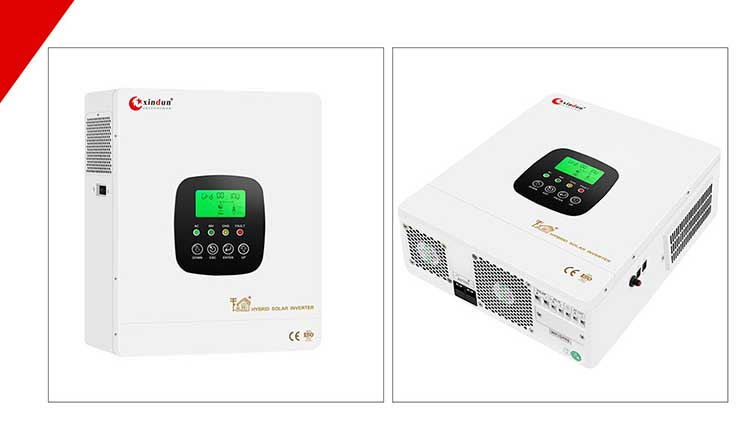
Xindun HFP on-grid and off-grid hybrid solar inverter 1.3KW-12.3KW, DC 24V/48V to AC 220V/230V/240V
Xindun HFP inverter is an on-grid and off-grid hybrid solar inverter with high-frequency bidirectional energy storage design. It gives priority to the use of solar energy. When the solar power energy is surplus, it is stored by the battery or fed to the grid. When the solar energy is insufficient, it is supplemented by the mains or battery for use by the load. It maximizes the use of solar power generation to achieve the purpose of self-power and self-use, and the purpose of surplus power being connected to the grid. It can set both the on-grid mode and the off-grid mode, and can also set the hybrid mode. It is a hybrid inverter that can meet both user needs at the same time, and is very suitable for the power demand of Iran power environment.
Xindun HFP-S Off-Grid Hybrid Solar Inverter (Dual Output)
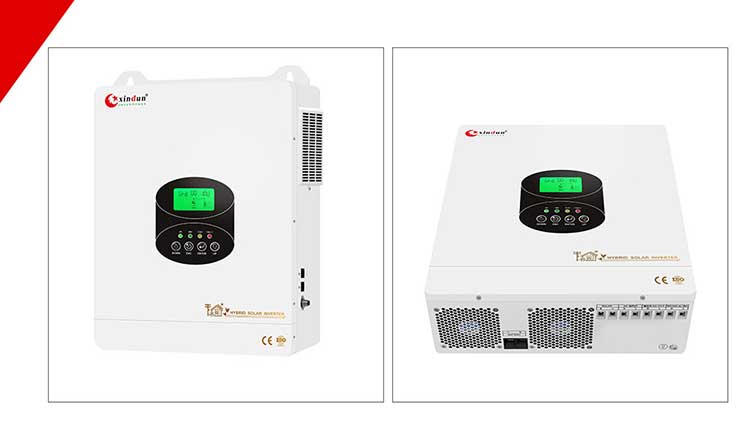
Xindun HFP-S (dual output) on grid and off grid hybrid solar inverter 1.3KW-12.3KW, DC 24V/48V to AC 220V/230V/240V
Xindun HFP-S series hybrid solar inverter not only inherits all the advantages of HFP series inverter, but also adds dual output function, providing users with richer and more flexible power solutions. HFP-S on grid and off grid hybrid solar inverter can connect two independent load circuits at the same time, and intelligent load management output. This design increases the flexibility and reliability of the system and is suitable for scenarios where power needs to be supplied to two different loads or devices at the same time.
Xindun HP PLUS+ Solar Inverter
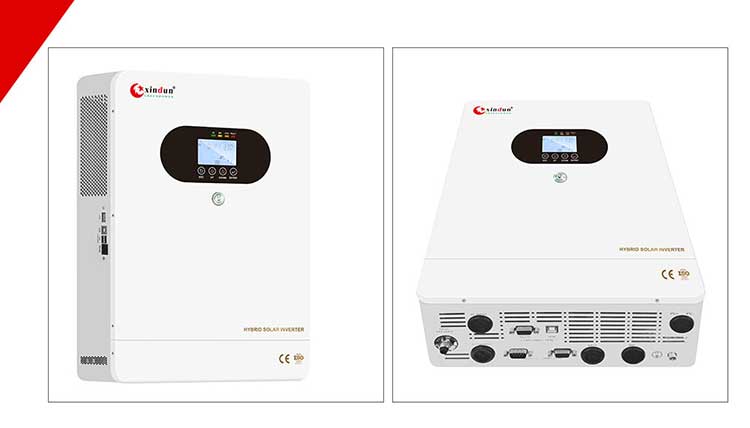
Xindun HP PLUS+ Solar Inverter 5000w, DC 48V to AC 208V/220V/230V/240V
If you install the inverter and feel that the power is not enough after a long time and need to expand the power by parallel connection, then this Xindun HP PLUS+ Solar Inverter can meet the user's future needs for power expansion. This solar inverter has a parallel connection function, which can not only parallel power, but also parallel three-phase and grid connection. A single machine with a power of 5000w can run up to 9 units in parallel. The single machine capacity of 5000w can be expanded to 10KW/15KW/20KW/25KW/30KW/35KW/40KW/45KW to meet your needs of different scales. High-frequency pure sine wave output, stable and reliable output, support battery-less operation mode, support single-phase/three-phase output, on grid power feeding function can be set, built-in mppt controller can be mixed with solar power and city power for intelligent allocation.
Xindun ESS-LI All In One Solar Power Generator
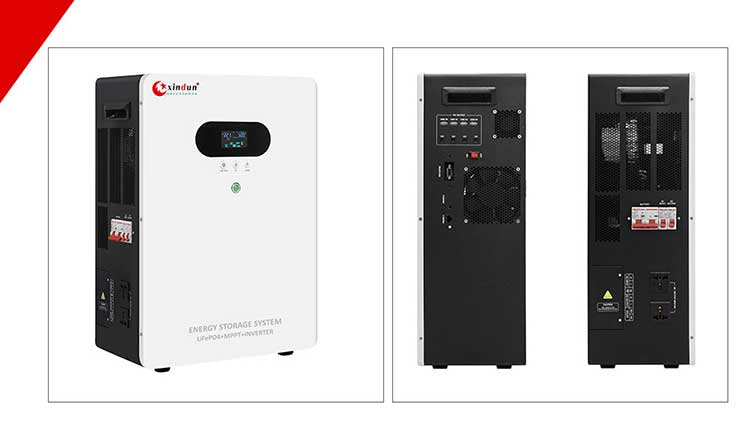
Xindun ESS-LI all in one solar generator 300w-7000w, DC 12V/24V/48V to AC 110V/120V/220V/230V/240V
If you are looking for a portable, plug-and-play, easy-to-install solar inverter, then the Xindun ESS-LI all in one solar generator will meet your needs. This is a solar inverter that integrates solar controller, inverter, and battery. It simplifies the installation and use process of the system and is more convenient to use. Suitable for outdoor use, camping, outdoor adventures and other scenarios. Provides output type interfaces to support AC and DC USB ports (5V, 12V) output to meet the power requirements of different devices. Using LiFePO4 lithium iron phosphate battery, it charges faster and stores more energy efficiently. The industrial frequency pure sine wave output provides a strong and stable output capacity to ensure the stable operation of the equipment.
Xindun HDSX Three-Phase Solar Inverter
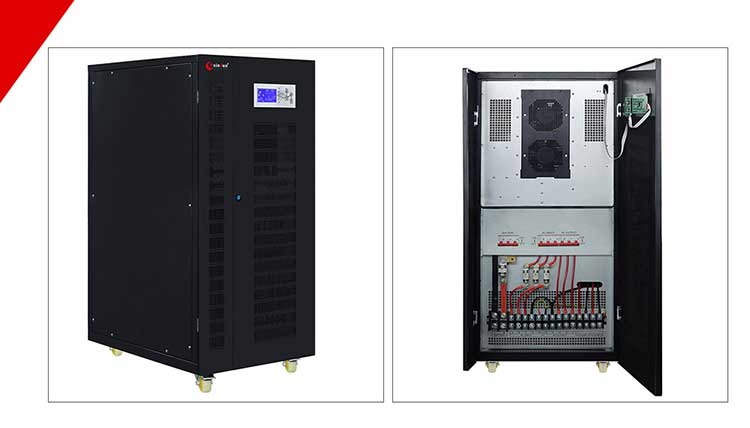
Xindun HDSX three-phase inverter 3.2kw-160kw, DC 48V/96V/192V/384V to AC 380V/400V
For medium and large commercial and industrial users, they generally need an inverter with high power and stable output. Then the Xindun HDSX three-phase solar inverter is an industrial three-phase solar inverter that is very suitable for industrial and commercial use. This three-phase solar inverter is designed to meet high-power and high-load industrial applications, with excellent conversion efficiency and stable output performance. It has three-input and three-output functions, adapts to a variety of battery types, meets diverse power needs, can easily cope with complex and changing industrial scene needs, and provides stable and reliable power guarantee for corporate users. At the same time, the Xindun HDSX three-phase solar inverter also has a UPS power supply function, which stabilizes the mains power and supplies it to the load when the mains power is normal, and charges the battery at the same time. When the mains power is interrupted, the DC power of the battery is immediately switched to AC power through the inverter to provide continuous and reliable power support.
VIII. Advantages of Chinese solar manufacturers in the Iran solar market
As the Iran solar market expands, many international solar companies have also entered the Iran solar market. These companies include solar manufacturers and solution providers from China, Europe and the United States. The investments of these companies are promoting solar and other renewable energy sources in Iran. development. Compared with the choices of European and American companies, Chinese companies have many solar manufacturers, such as HUAWEI, SUNGROW, GROWATT, and Xindun, with rich and diverse product solutions, high cost performance, leading technology, and reliable product quality. Chinese solar companies have the following advantages in the Iran solar market:
1. Technology leadership: Chinese solar manufacturers have invested heavily in technology research and development and have a number of core technologies and patents to provide efficient, stable, safe and reliable solar products. These products adhere to the highest international standards during design, manufacturing and testing, ensuring their competitiveness in the Iran solar market.
2. Price advantage: Chinese solar manufacturers have significant advantages in cost control, which benefit from the well-established domestic industrial chain and economies of scale. Therefore, Chinese companies are relatively more competitive in terms of price and can meet the demand for cost-effective products in the Iran solar market.
3. Brand influence: The brand influence of Chinese solar companies in the international market continues to increase, and the market share of some domestic brands in Iran also continues to grow. This is due to the comprehensive performance of Chinese companies in product quality, price, service, etc. Advantages and Iran customers’ trust and support for Made in China.
4.One Belt, One Road: With the in-depth implementation of the “One Belt, One Road” initiative, cooperation between China and Iran in the energy field is increasingly strengthening. This provides more opportunities for Chinese solar manufacturers to find partners and expand business in the Iran market.
IX.Why choose Xindun solar inverter system?
As a global high-quality solar power manufacturer, Xindun has a good market reputation in the industry. Xindun solar inverter system products are exported to more than 100 countries and regions overseas, and are also the source of OEM for local solar companies in many overseas regions. Xindun can provide cost-effective solar power systems for domestic and foreign trading companies, dealers, and engineering projects. At the same time, it can also provide you with 1V1 professional customization services, tailor-made a solar power system solution suitable for you to meet your solar project needs. Dealers can obtain the following through cooperation with Xindun:
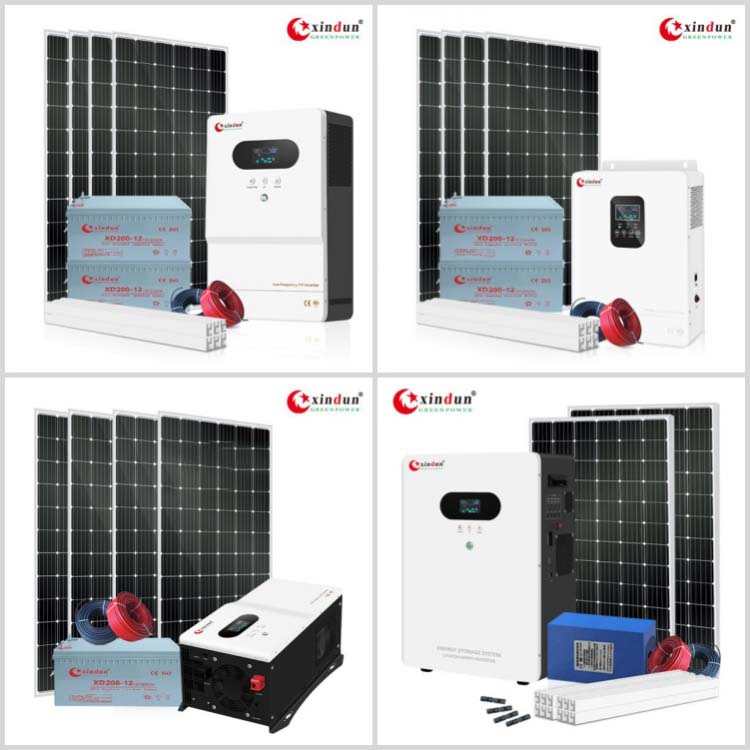
1. Product diversification: Xindun provides a variety of products of different types and specifications to meet the diverse needs of dealers in different markets and customer groups. There are not only solar power systems with different power ranging from 300W to 160KW, but also solar system components such as solar inverters, solar controllers, batteries and solar panels, such as on grid and off grid hybrid inverters, power frequency inverters, high frequency inverters, inverter controlled energy storage integrated machines, mppt/pwm controllers, lithium/lead-acid batteries, solar panels and other full-set products.
2. Customized services: Xindun can provide dealers with 1V1 customized services. According to customer needs and market trends, it provides customized solar power systems, which helps dealers stand out in the local market competition and meet the customization needs of local customers. The solar energy system provided by Xindun is not only a product, but also a one-stop solar energy solution service to ensure the successful installation and operation of customers' solar projects.
3. High-quality products: Xindun continues to invest in product research and development and continuously launches products with innovative technologies. Choosing Xindun products means leading technology, making you more competitive in the local market. While ensuring product quality, Xindun also provides dealers with a reasonable profit margin. Through production supply chain management, we create more market business opportunities for you, increase profit margins, and make you stand out in the fiercely competitive market.
4. Service support: Xindun provides product training, marketing promotion, after-sales service, etc. Through regular product knowledge training and after-sales training, we help dealers increase their influence in the local market. At the same time, we also provide dealers with after-sales service training systems, etc., to improve dealers' local after-sales guarantee services.
X. How long can the Xindun solar power system run?
The Xindun solar power system uses high-quality solar components. The service life of the solar panels can be up to 25 years, the solar inverter can run for up to 10 years, and the battery life is 2-5 years. Xindun Power has more than 18 years of manufacturing experience and a team of more than 30 engineers for R&D and design. Every year, it organizes and participates in extensive exchanges and sharing of professional knowledge around the world. It has visited 68 countries for inspection and research, including no less than 10 visits to the Middle East, including Iran. It has rich experience and excellent professional skills applied to the research and development of local solar energy systems. Before providing the solar power system to customers, the system will undergo various quality tests, such as input voltage and current testing, wire inspection, overload testing, efficiency testing and safety testing. The product passes the third-party testing center to ensure product quality. As a key equipment in the solar power system, Xindun independently develops, designs and produces high-quality inverters. Among them, 10 inverter R&D and design engineers and 20 solar system solution design special teams provide customers with efficient solar energy solutions and products. Xindun solar power system can also be controlled through WIFI & mobile phone APP, which allows you to always control the system operation status, which is very convenient.
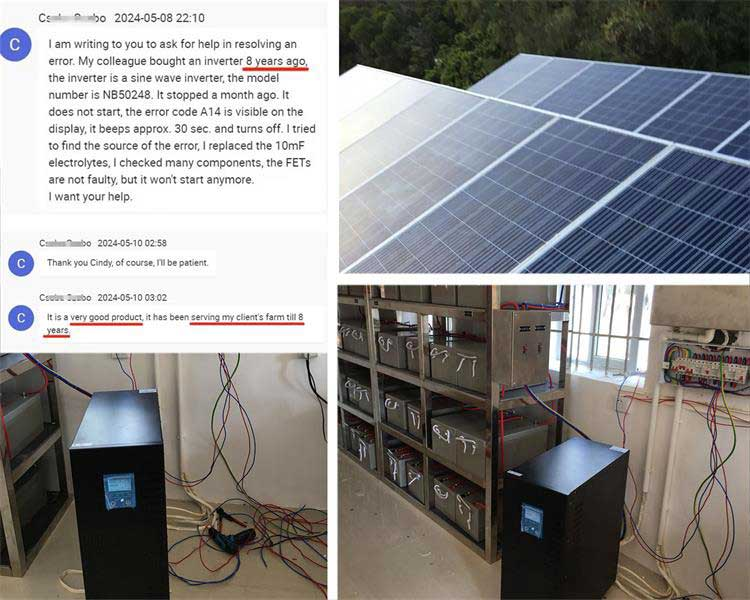
Let me share with you a 5kw solar power system installed by our customer in 2016, which is used in the customer's farm. It has been 8 years since then. The customer sought after-sales help through the business manager on May 8, 2024. After the after-sales engineer of Xindun provided technical guidance, the system is still operating normally.
Xindun Power was founded in 2006 and has been deeply engaged in the innovation and research and development of solar power systems, inverters, solar controllers, solar panels and batteries. With its excellent product quality and technical strength, Xindun has continuously won the trust and praise of customers around the world.
As a professional solar power system manufacturer, Xindun has a variety of solar products, such as inverters, off-grid hybrid inverters, high-frequency inverters, industrial frequency inverters, inverter-controlled energy storage integrated machines, MPPT/PWM solar controllers, lithium batteries and other products. Xindun can not only meet the conventional needs of customers, but also customize production according to the special requirements of customers, providing a full range of services from product design, production to after-sales.
If you want to learn about or purchase Xindun solar power systems or inverters and other products, whether you are an Iran customer or a domestic or foreign customer, you can leave your information and needs in the customer service window at the bottom of the website (http://www.xinduninverter.com). Xindun will contact you as soon as possible during working hours.

 Solar Inverter
Solar Inverter





 Hybrid Inverter
Hybrid Inverter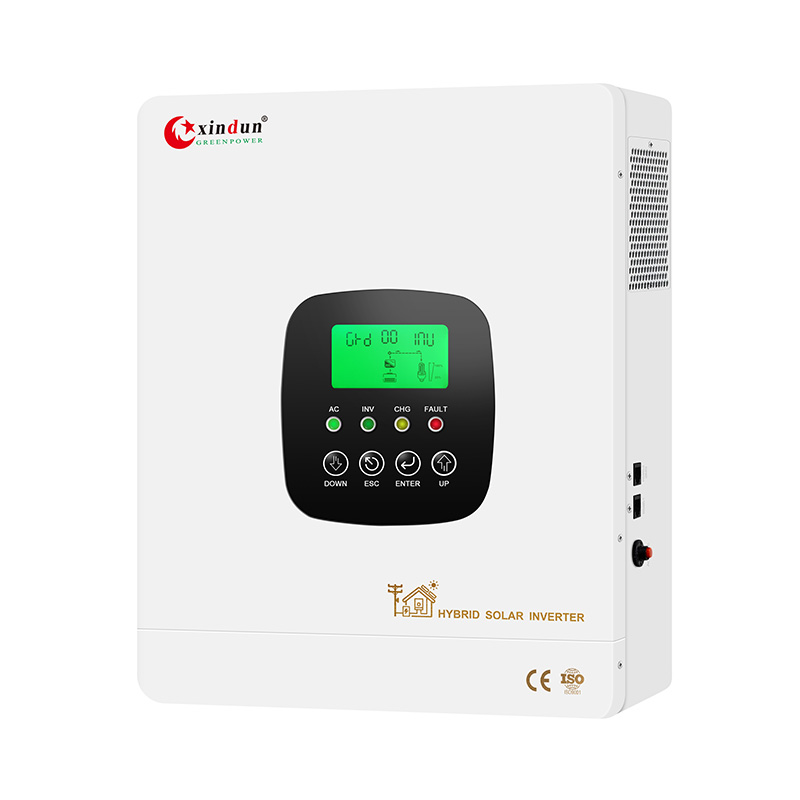
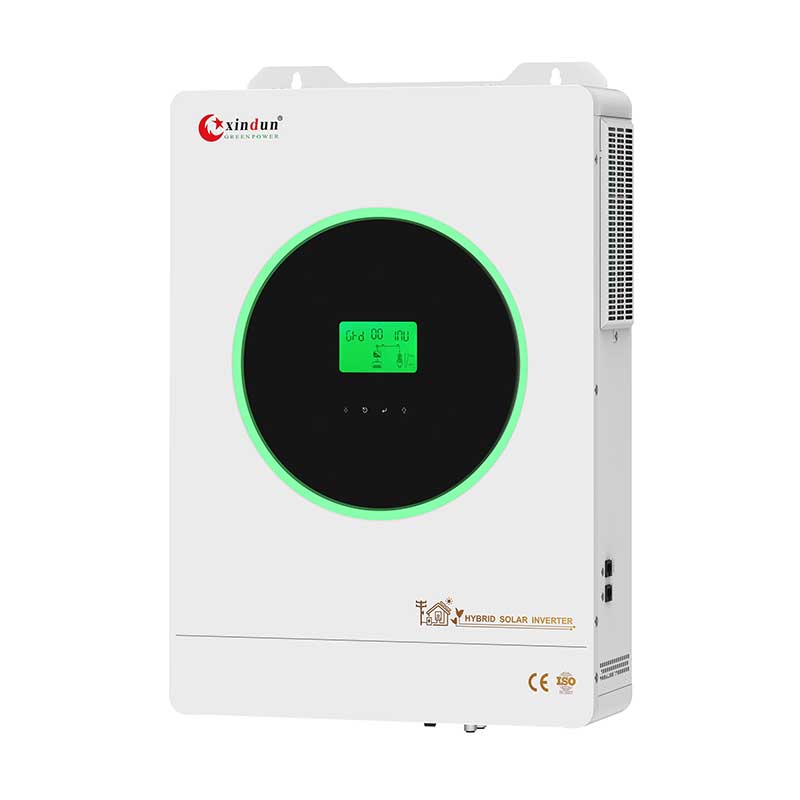
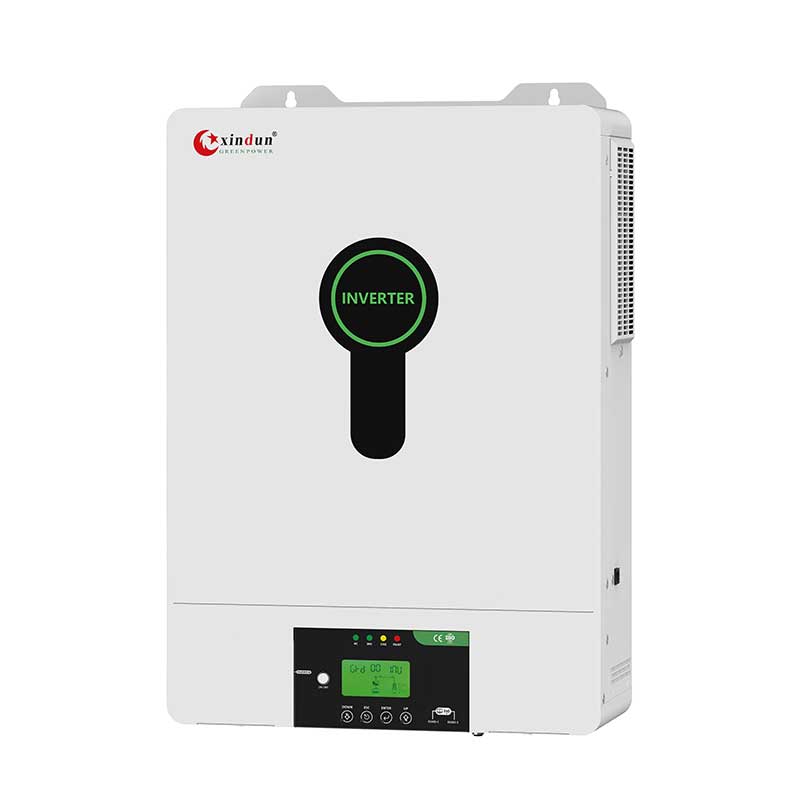


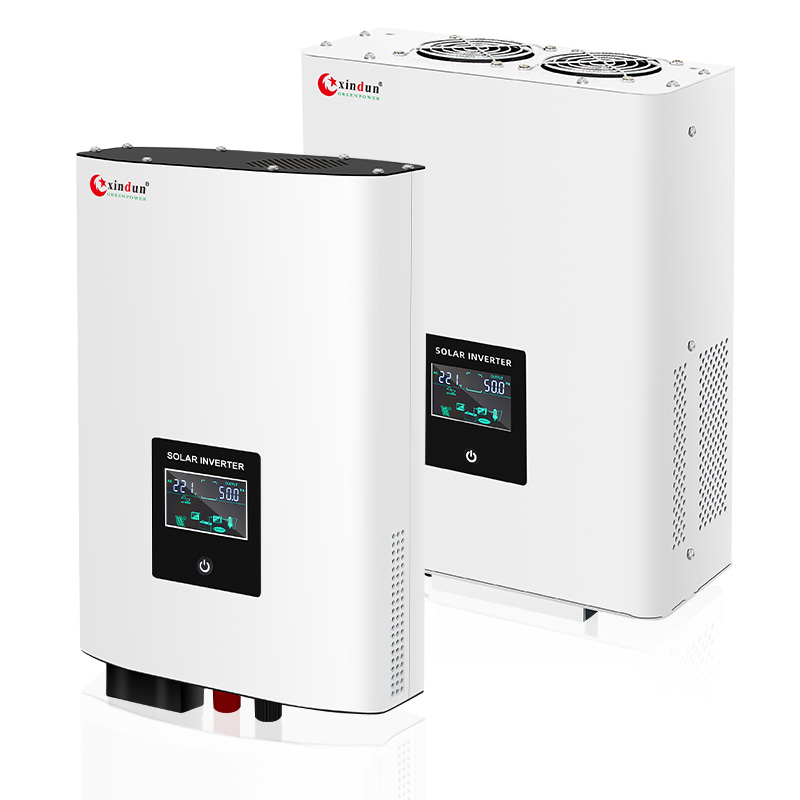
 Power Inverter
Power Inverter
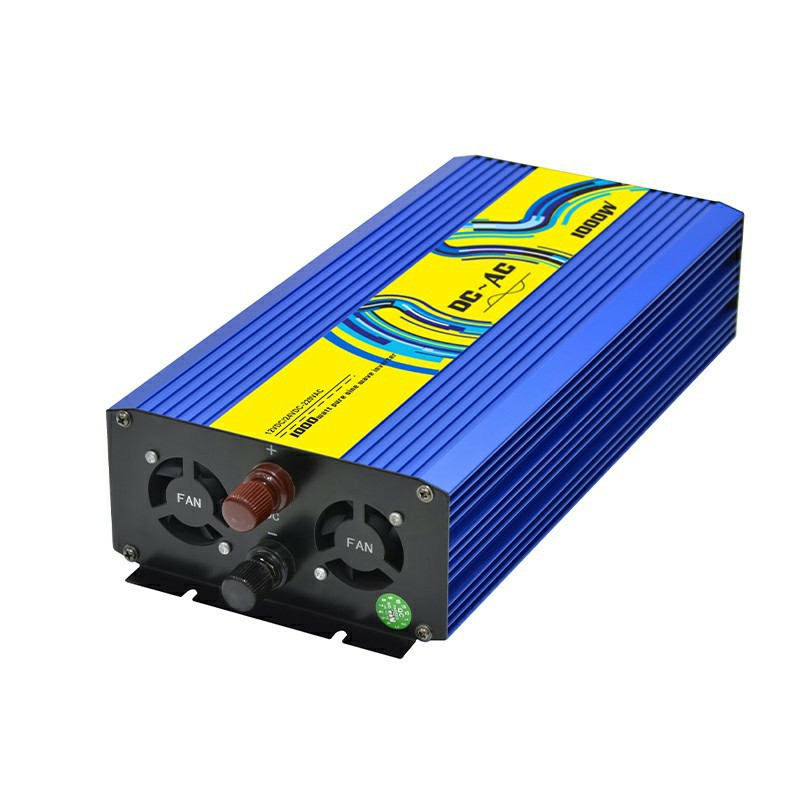


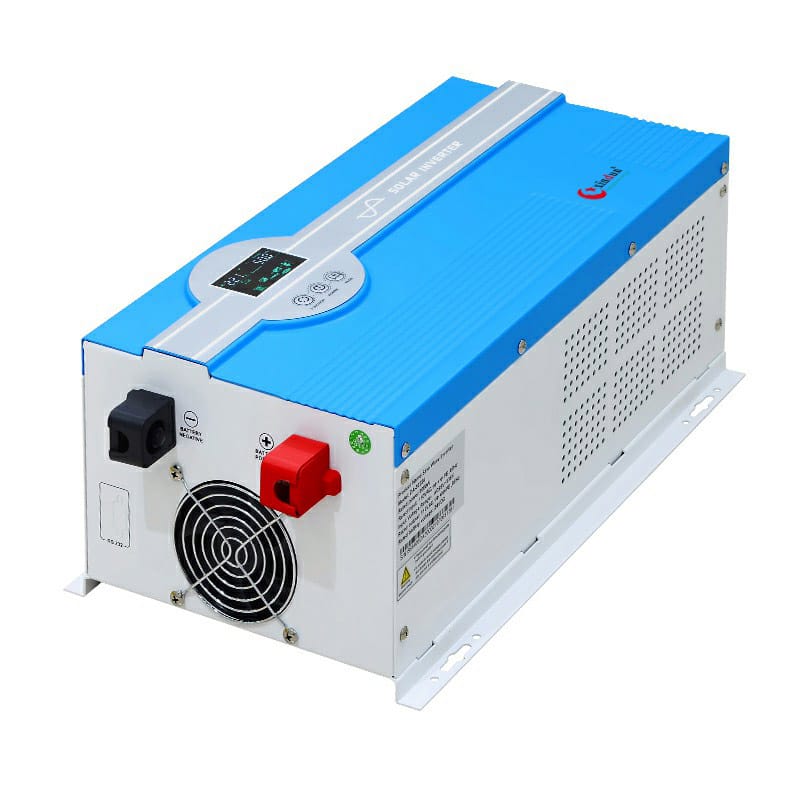
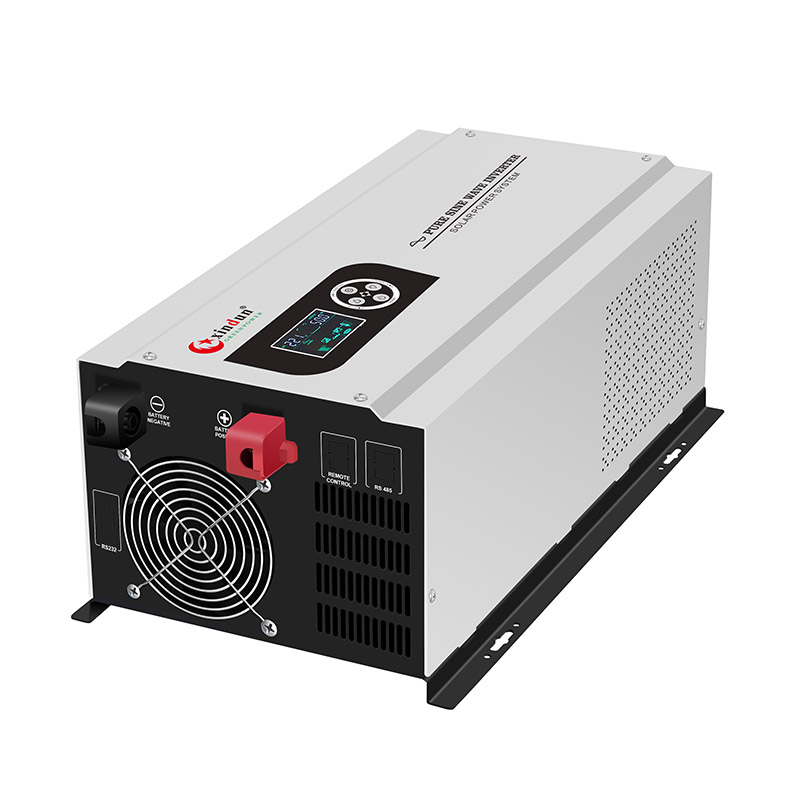
 Split Phase Inverter
Split Phase Inverter

 Energy Storage Inverter
Energy Storage Inverter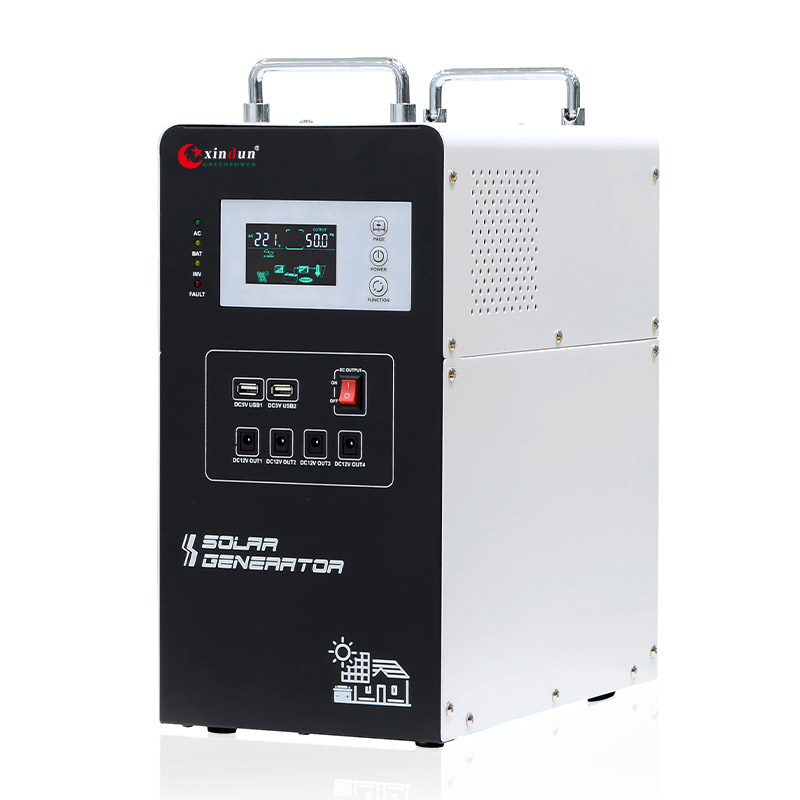




 3 Phase Inverter
3 Phase Inverter
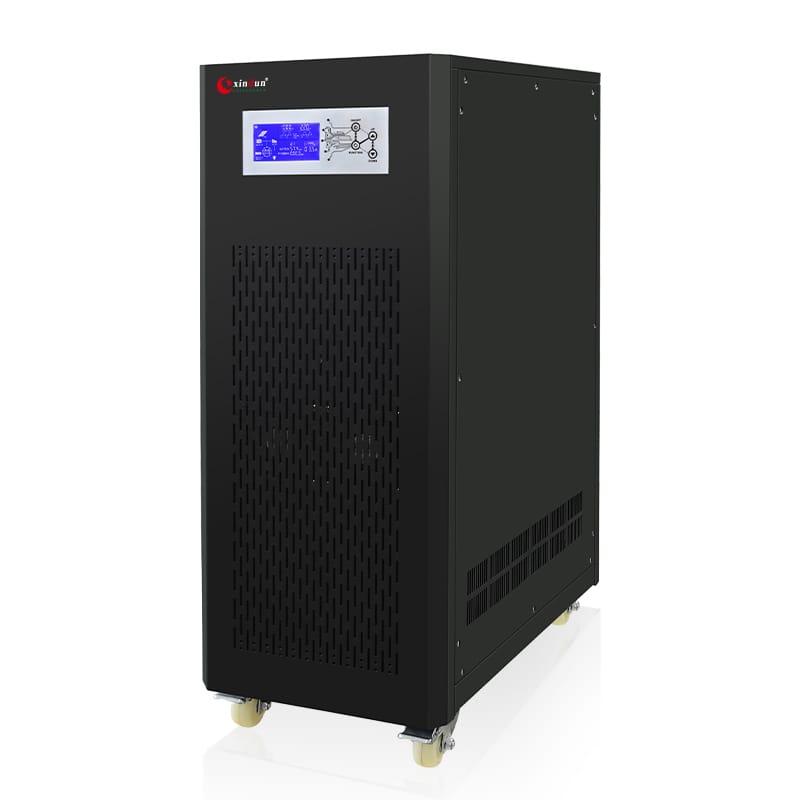



 Solar System Kits
Solar System Kits





 Solar Charge Controller
Solar Charge Controller
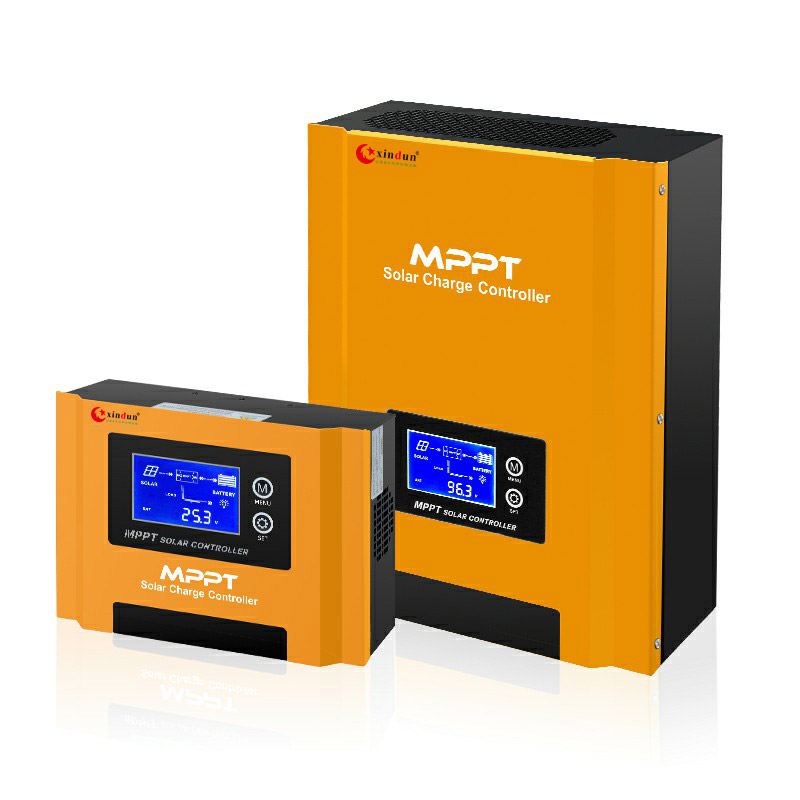

 Solar Battery
Solar Battery



 Asia
Asia
 Africa
Africa



 South America
South America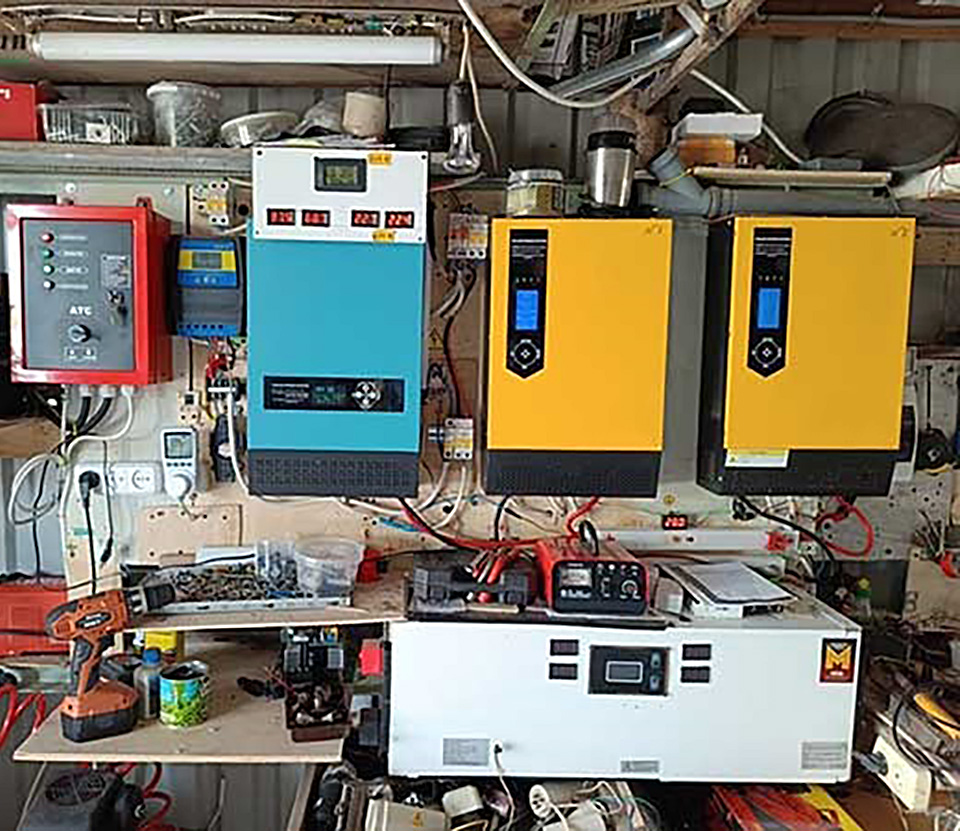
 Europe
Europe

 North America
North America

 Oceania & Antarctica
Oceania & Antarctica










 Home
Home Zambia's Solar Energy Market Development and Inverter Recommendations
Zambia's Solar Energy Market Development and Inverter Recommendations  Top Selling Products
Top Selling Products














